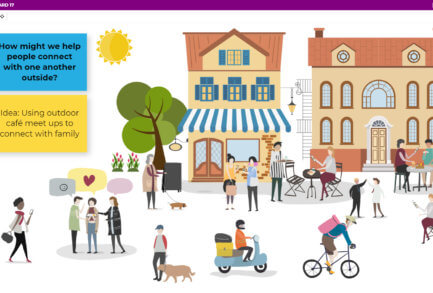Why learning design thinking online makes students better innovators
Remote learning suddenly switched from being one part of a university’s offering, to its entire way of working this year. While this has been a huge adjustment for professors and students alike, this shift has highlighted the many benefits that teaching and learning design thinking online brings.
We’ve worked with universities around the world to help them take their innovation courses online this year using Sprintbase. We’re seeing students come away better prepared to use their design thinking skills in the working world because of the opportunities doing innovation remotely has given them.
Here we share three ways that remote innovation learning is better equipping students to become future innovators.

They know how to navigate times of uncertainty
Everybody, no matter where they are in their lives right now, has had to find their way through the uncertainty and changeability of 2020.
And though this will have been enormously challenging for students expecting a mostly face-to-face course experience, navigating this time has given them invaluable experience they can apply in the workplace.
Neither students nor professors have known how well this new online teaching approach would work, how long it will last, how their teaching and learning experience will change in the long term, or when this pandemic will end. Nonetheless, they’ve still had to work together to get results, and keep moving forward regardless of ambiguity.
This is exactly what it’s like when you’re running a real innovation project. Things change every day, you have to take risks, work outside your comfort zone, try new things, and keep learning as you go.
There’s so much synergy between the challenges students have had to navigate this year, and what it will feel like to work through problems in a business context. The reflexes they’ve developed during this time will be incredibly useful when they’re working on innovation projects in day-to-day roles.

They’re comfortable contributing to ongoing innovation projects
Since moving innovation courses online, universities have been able to let students contribute to various projects more flexibly than they might have before. Rather than meeting for in-person classes and doing all of their project work in the room, students are being given content they can engage with that better aligns with their home lives, time zones and schedules, and the opportunity to contribute to projects online any hour of the day.
We’re seeing organizations working in a similar way. Before the pandemic, many felt they had to use a one or two day workshop to bring their people together and get everybody’s contributions there and then. But now that people are working remotely, more leaders are choosing to run longer, remote innovation projects, which enable people to contribute flexibly, and offer the opportunity to involve people from across the business, and the world.
So, again, students are gaining experience through online design thinking courses that will set them up for innovation in the real world. They’ll be ready to fit into how organizations innovate – and contribute to multiple projects at a time if needed – because they learned how to do exactly that on their courses.

They know the value of meaningful collaboration – and how to do it beyond their immediate community
Whether they’re building empathy, seeking feedback, or doing any other part of their project that involves speaking to people, when working remotely, students can access anyone they want, anywhere in the world.
Whereas previously they’d likely only be able to speak to fellow students, businesses or people within their campus or city, now they can communicate across time zones if they wish.
This is a skill and an understanding that employers want. More and more corporations are running longer innovation projects online so that they can benefit from a breadth of input from across cities, countries and even continents.
Students who have been through online design courses where they’ve had experience engaging people from all walks of life with innovation remotely will be able to hit the ground running in organizations wanting to do the exact same thing.
Looking for an easy way to move your design thinking course online and give your students an amazing, hands-on learning experience? With Sprintbase you get a ready-to-run project based learning experience right out of the box. Find out more.
More from the blog

How to create beautiful prototypes remotely
We’ve revolutionized our whiteboards on Sprintbase, so that anybody – whether you’re creative or not – can produce beautiful, illustrated prototypes in minutes.

The business case for curiosity
Harvard Business School’s Professor Francesca Gino has conducted fascinating research into the power of curiosity in the workplace. Many of the most curious among us shy away from their natural bias to ask why, due to fears of being labelled as ‘out of line’ or ‘asking too many questions’.

How to secure support for your innovation project
We’ve seen it happen far too many times. A great innovation project gets all the way through to completion, but then it goes nowhere, because it doesn’t have leadership buy-in. Unless a project has true…
Get a free trial
Contact us to get your free trial or to talk about how Sprintbase can help you achieve your remote innovation goals.
Get started





